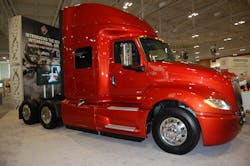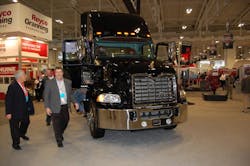NASHVILLE. A speech by Troy Clarke, president and CEO of Navistar, here at the 2017 Technology & Maintenance Council (TMC) annual meeting echoed many of his previous comments regarding how the “connected truck” is going to upend traditional freight shipment practices in the U.S.; an outlook shared by other suppliers and industry advocates attending the show.
Clark explained that boosting truck utilization via various technological systems offers a “tremendous alignment” of interests for fleets, shippers, and anyone else involved in the freight industry, as more connected trucks not only makes fleets more efficient but improves distribution networks for shippers while potentially helping reduce “congestion pressures” by decreasing the number of trucks required for freight service.
“The connected truck is that platform, the access point for all the data,” Clarke stressed.
Chris Spear, president and CEO of the American Trucking Associations (ATA) – the parent organization for TMC – expressed similar thoughts regarding how technology will change trucking, especially in terms of autonomous systems.
Though the adoption of truly self-driving trucks remains a long way off – some 20 to 25 years in ATA’s view – Spear’s believes they offer a more serious “business case” for motor carriers compared to everyday motorists.
That “business case” is largely predicated on maximizing uptime for commercial vehicles, noted Conal Deedy, director of connected vehicle services for Volvo Trucks, who emphasized that, on average, each additional day of uptime equates to about $1,100 in additional revenue for a truck operator.
Chris Villavarayan, president of the Americas for Meritor, explained to Fleet Owner that going forward suppliers and OEMs alike are focused on three major design elements when it comes to commercial vehicles: efficiency, safety and driver comfort – with all three affected by the growing use of technology.
“When we talk safety, for example, we’re talking about radar; we’re talking about ADAS [advanced driver assistance systems]; and we’re talking about automatic emergency braking,” he explained to Fleet Owner.
When it comes to driver comfort, Villavarayan said it is about using items such as electronic logging devices (ELDs) that – though frowned on by many traditional drivers – relieve them of the “burdens” associated with operating a commercial vehicle.
“Platooning and autonomous vehicle operation will also help where driver comfort is concerned,” he said.
David Pardue, vice president of connected vehicle and uptime services at Mack Trucks, explained to Fleet Owner that motor carriers themselves, large and small alike, are quickly “maturing” where discussions of such technologies are concerned.
“The types of questions we are fielding today are light years from where we were just three years ago,” he said. “It’s not just about being compliant with the ELD mandate anymore; it’s about how do I leverage that technology to handle fuel tax reporting, provide tracking and tracing, and many other services.Scott Barraclough, Mack’s technology product manager, added that a lot more fleets are “getting comfortable” with these technology discussions, especially in terms of the rapid software development pace for “back office” needs will change trucking.
“More back office connectivity is also putting more pressure on us to come up with better solutions,” Pardue added. “In many ways, we see our [trucking] customers progressing faster in this area. Dealers are certainly comfortable selling on specifications, fuel economy, and vehicle price. Connectivity is different.”
Yet Stu Russoli, Mack’s highway and powertrain products marketing manager, pointed out that more and more customers are demanding truck connectivity for an ever-widening array of reasons.
“For example, fleets are coming in to ask for more safety systems to reduce their liability exposure; that’s a big monetary factor for them,” he said.
About the Author
Sean Kilcarr
Editor in Chief
Sean Kilcarr is a former longtime FleetOwner senior editor who wrote for the publication from 2000 to 2018. He served as editor-in-chief from 2017 to 2018.


